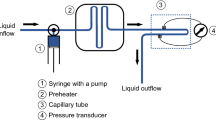Abstract
According to the feature of resin matrix composites in the autoclave process, the resin flow state is mainly driven by resin pressure. Therefore, achieving online monitoring of resin pressure changes will provide effective guidance for the selection of autoclave parameters and the analysis of component forming quality. In this work, an online monitoring system of resin pressure was established using a capillary sensor, and the accuracy and responsiveness of the system were studied through a hysteresis test and main factor optimization. The change of resin pressure in the whole curing process of the composite laminates was further evaluated. Results showed that the system had the characteristics of high accuracy and fast response when the capillary tube diameter was 0.8 mm and the viscosity of silicone oil was controlled in the range of 0.05–0.5 Pa.s. For T800/X850 composite laminates, the best pressurization time was obtained when the curing temperature raised to 60 ℃. At the same time, resin pressure bear most of the external pressure during the zero bleeding process, which was less sensitive to the thickness of the samples. The values of resin pressure evenly distributed along the thickness direction and did not fluctuate.
Graphical abstract













Similar content being viewed by others
Data availability
All relevant data are within the paper.
References
Demircan G, Ozen M, Kisa M, Acikgoz A, Işıker Y (2023) The effect of nano-gelcoat on freeze-thaw resistance of glass fiber-reinforced polymer composite for marine applications. Ocean Eng 269:113589
Ozen M, Demircan G, Kisa M, Acikgoz A, Ceyhan G, Işıker Y (2022) Thermal properties of surface-modified nano-Al2O3/kevlar fiber/epoxy composites. Mater Chem Phys 278:125689
Marchandise A, Keryvin V, Grohens Y, Le Borgne R (2023) Influence of the lay-up and curing steps in the manufacturing process of thick laminate composites on their compressive strength. Compos Part A-Appl S 164:107302
Yang XB, Zhan LH, Jiang CB (2020) Analysis of porosity and mechanical behavior of composite T-joints produced by random vibration-assisted vacuum processing. Iran Polym J 29:759–770
Coulon P, Chatelain J-F, Dubé M, Rimpault X (2018) Effect of curing pressure on machinability of carbon fiber composite. Procedia CIRP 77:307–310
Liang Q, Feng X-P, Zhang K, Hui X-M, Hou X, Ye J-R (2022) Effect of curing pressure on the curing behavior of an epoxy system: curing kinetics and simulation verification. Polymer 256:125162
Kumar D, Choudhary V (2020) Curing kinetics and thermal properties of imide containing phthalonitrile resin using aromatic amines. Thermochim Acta 693:178749
Hassan MH, Othman AR (2017) Contribution of processing parameters on void content in the vacuum bagging configurations of L-shaped composite laminates. Int J Adv Manuf Technol 93:1333–1345
Liu L, Zhang B-M, Wang D-F, Wu Z-J (2006) Effects of cure cycles on void content and mechanical properties of composite laminates. Compos Struct 73:303–309
Campbell FC, Mallow AR, Browning CE (1995) Porosity in carbon fiber composites an overview of causes. J Adv Mater-Covina 26:18–33
Campbell FC (2004) Manufacturing processes for advanced composites. Elsevier Advanced Technology, Oxford
Walczyk D, Kuppers J (2012) Thermal press curing of advanced thermoset composite laminate parts. Compos Part A-Appl S 43:635–646
Lynch K, Hubert P, Poursartip A (1999) Use of a simple, inexpensive pressure sensor to measure hydrostatic resin pressure during processing of composite laminates. Polym Composite 20:581–593
Ganapathi AS, Maheshwari M, Joshi SC, Chen Z, Asundi AK, Tjin SC (2016) In-situ measurement and numerical simulation of resin pressure during glass/epoxy prepreg composite manufacturing. Measurement 94:505–514
Gu YZ, Zhang ZG, Li M (2007) Resin pressure measuring system for hot pressing process of composites. Acta Materiae Compositae Sinica 24:23–27
Sun K, Li M, Gu YZ, Xin C, Zhang Z, Liu J (2010) Resin pressure online measuring and evolution during autoclave zero-bleeding process. Acta Materiae Compositae Sinica 27:94–99
Alshahrani H (2020) Influence of pre-consolidation parameters on the preforming deformation mechanisms of polymeric composites. Mater Today Proc 28:879–882
Demircan G, Kisa M, Ozen M, Aktas B (2020) Surface-modified alumina nanoparticles-filled aramid fiber-reinforced epoxy nanocomposites: preparation and mechanical properties. Iran Polym J 29:253–264
Demircan G, Kisa M, Ozen M, Acikgoz A (2021) Quasi-static penetration behavior of glass-fiber-reinforced epoxy nanocomposites. Mech Compos Mater 57:503–516
Chang TF, Zhan LH, Tan W, Li S (2017) Void content and interfacial properties of composite laminates under different autoclave pressure. Compos Interface 24:529–540
Acknowledgements
The authors would like to gratefully acknowledge the funding from the National Natural Science Foundation of China, 51975208, the Science and Technology Innovation Program of Hunan Province, 2020RC4001, the Natural Science Youth Fund of Hunan Province, 2020JJ5183 and the Doctoral Research Startup Fund of Hunan University of Science and Technology, E52077. The authors would like to gratefully acknowledge the research team members of Central South University and Hunan University of Science and Technology for their support and useful discussions in this research work.
Author information
Authors and Affiliations
Corresponding author
Ethics declarations
Conflict of interest
There is no conflict of interest to all authors.
Rights and permissions
Springer Nature or its licensor (e.g. a society or other partner) holds exclusive rights to this article under a publishing agreement with the author(s) or other rightsholder(s); author self-archiving of the accepted manuscript version of this article is solely governed by the terms of such publishing agreement and applicable law.
About this article
Cite this article
Chang, Tf., Zhan, Lh., Zou, X. et al. Resin pressure monitoring method and variation in autoclave processing of polymer composite laminates using capillary sensors. Iran Polym J 33, 25–34 (2024). https://doi.org/10.1007/s13726-023-01232-2
Received:
Accepted:
Published:
Issue Date:
DOI: https://doi.org/10.1007/s13726-023-01232-2




